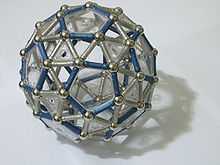Geomag

Geomag is the brand name of a toy construction system created in 1998, consisting primarily of nickel-plated steel balls (spheres) (0.50",12.7mm in diam) and short connecting sticks (27mm) with a magnet on each end (rods). With these two basic elements, a huge number of geometric shapes and structures can be built. Adding panels helps to form rigid structures. Geomag can be used also to make experiments with magnetism and moving structures.
Use
Models are constructed by magnetically connecting the rods and spheres together in a lattice formation. Panels fit between the rods and shapes include triangle, diamond, square and pentagon.
Homemade experiments show that each stick can produce up to roughly 4.116N of force when attracting iron. Builders report that construction of ceiling-high pendulums is possible.
Structures can easily be built and taken apart making building complex structures relatively easy. Such exercises teach children important lessons about problem solving, creativity, and physics. Geomag was named the 2005 Toy of the Year by the Toy Industry Association.
They are also a popular office executive toy and increasingly used in more serious mathematical and scientific presentations.[citation needed]
History
Geomag was invented by Edoardo Tusacciu, founder of Plastwood a company located in Calangianus, Sardinia, Italy in 1998. In 2003 the production was moved in Switzerland. [1] [2] [3]
Geomag updated its line by introducing the new Geomag Gift Range in early 2006. This new Premium line comprises special colored rods — and either Makrolon polycarbonate panels from Bayer Material Science AG, or rare Wengé Wood panels. These are no longer available.
In late 2009, Geomag changed and reorganized its line into three categories: GBaby, Geomag Kids, and Geomag Pro. The GBaby line contains large magnetic geometric and animal shapes suitable for babies as young as 10 months. The Geomag Kids line has rods that are longer than the original rods (58mm vs. 27mm) suitable for kids as young as 3 years. The Geomag Pro line is a continuation of the classic Geomag pieces, with new color themes, suitable for ages 6 through adult. The Geomag Forum was also newly restarted, providing a place for Geomag enthusiasts to exchange pictures and ideas. in 2010, 2011 and 2012 Geomag introduced many different lines including: Wheels line (adding wheels and plastic structures as to make vehicles that really works), Glow in the dark line (Glow), Pink line (designed for girls) and e-motion line (mased on movement and magnetic adventures).
Similar toys
There are several other toy systems similar to Geomag, many of which seem to be compatible with Geomag but in reality are not totally compatible due to the precise length of bar needed to create true geometric forms which are consistent and stable. Geomag is the owner of many patents and the only one produced in respect of EN 71 law. For example:
- Madmag
- Magic Joint
- Magmax
- Magnetix
- Magnext
- Magstix
- Magz
- Supermag * Also has twist bars with screw ends and 2 sizes of spheres (10mm and 12.7mm) with screw holes.
- Xmag
- '*' Prior to 2003 Supermag and Geomag were both produced by PlastWood, an Italian company. In 2003 PlastWood discontinued the Geomag line in favor focusing on its Supermag line, which the company felt to be more versatile.[4]
Thanks to its patents, Geomag restarted the production in Switzerland and is now leader in magnetic construction toys.
Some of the above have added features, such as bars of differing (or even adjustable) length, curved bars, or bars connecting to three or more spheres.
Most magnetic ball and bar systems have a few weaknesses. A vertex ball with many magnets attached may need some of them flipped to balance the North and South forces of the connections for maximum strength. The magnets add a lot of weight to a structure, limiting the maximum size that can be built. The balls allow bars to spin and shift freely, so the structure either needs extra supporting beams or panels to hold its shape. This doesn't happen with Geomag products that have neodymium magnets and a metallic spine that channels magnetic flux. This is a patent owned by Geomag
External links
References
- ↑ http://lanuovasardegna.gelocal.it/regione/2010/04/16/news/plastwood-il-gioco-e-finito-1.3321798 Plastwood, il gioco è finito
- ↑ http://epaper2.tagesanzeiger.ch/ee/ilca/_main_/2011/06/12/014/article/11 E così un’azienda rinasce per divertimento
- ↑ http://www.nomads.it/continua.php?cod=85&pagina=7 Edoardo Tusacciu, ha buttato il sughero e si è tenuto un bel gioco
- ↑ Plastwood press release